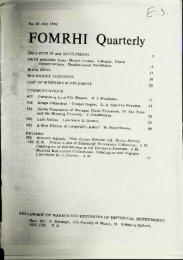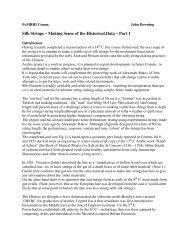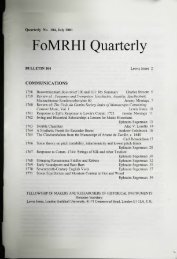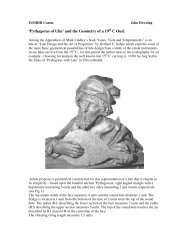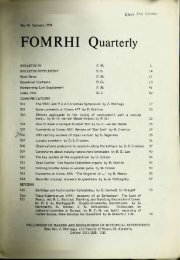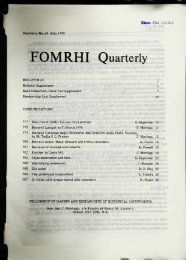• I f - FoMRHI
• I f - FoMRHI
• I f - FoMRHI
Create successful ePaper yourself
Turn your PDF publications into a flip-book with our unique Google optimized e-Paper software.
22<br />
Replacement of I and II by steel harpsichord strings (variants 4 and 5) was not a rewarding<br />
experience, and turned the instrument into something resembling my 12 year old niece's<br />
school violin. This left me puzzled by Evelyn's report, but I did not persist with variant 6.<br />
Instead, I tried listening to a recording of Swedish folk tunes played on modem metal-strung<br />
fiddles (not scordatura tuned), to try to persuade myself whether the sound could be<br />
described as 'sweet' as in Evelyn's account, or 'breathy', which might explain the use of the<br />
adjective 'piffaro'. Such judgments are inevitably subjective, and although I was personally<br />
not convinced, it is possible that others might be.<br />
Variant 3 (metal strings for III and IV only) produced a rather pleasant echo-like resonance,<br />
particularly with the strings tuned a' - e" - a' - e". It was not difficult to persuade oneself that<br />
metal strings work well as sympathetic strings. Also, even at the low Corista pitch standard<br />
of a' = 380 Hz, for a violin of string stop 32 cm the fL product (frequency in Hz x string stop<br />
in m) of the e" string is 182 m/s, which is actually higher than maximum of around 174 m/s<br />
expected to be tolerable with the metal strings available after 1620 (Comm 1593); so the<br />
breakage rate of metal strings would have been high if bowed, but probably acceptable if<br />
not. However with a shorter string stop of 30 cm, bowed metal strings should be feasible.<br />
Finally I returned to the original gut/overspun gut stringing (variant 2) but this time with the<br />
strings tuned a - e' - a 1 - e" at Corista pitch. This yielded a result similar to variant 3, and<br />
made me wonder whether metal stringing was actually necessary. In this case Spielmann<br />
may have been essentially correct but was not aware that tuning is at least as critical to the<br />
response of a Stainer violin as the strings themselves.<br />
The preferred options for Schmelzer's violino piffaro are therefore:<br />
(1) a standard size violin, with gut for the top two strings, and overspun gut for the<br />
bottom two strings tuned in octaves with the top two<br />
(2) a standard size violin, with gut for the top two strings, and metal for the bottom two<br />
strings tuned in unison with the top two<br />
(3) a small violin, metal-strung throughout, tuned as in (2)<br />
In all cases the bottom two strings are treated as sympathetic not played strings. Evidence in<br />
favour of (2) on other instruments includes variants of the lyra viol, the later type of viola<br />
d'amore and the baryton. Evidence in favour of (3) includes Evelyn's account and the early<br />
type of viola d'amore. The Hardanger fiddle dated 1651, shown in Grove, has 4 played<br />
strings and 4 sympathetic strings, all metal; but it is not clear what its size is nor whether the<br />
original bowed strings were metal or gut. I would be interested in any other evidence that<br />
could point towards any of the various options. At present I can only conclude that the allmetal<br />
version (3) is the one which would contrast most strongly with the normal violin band.





